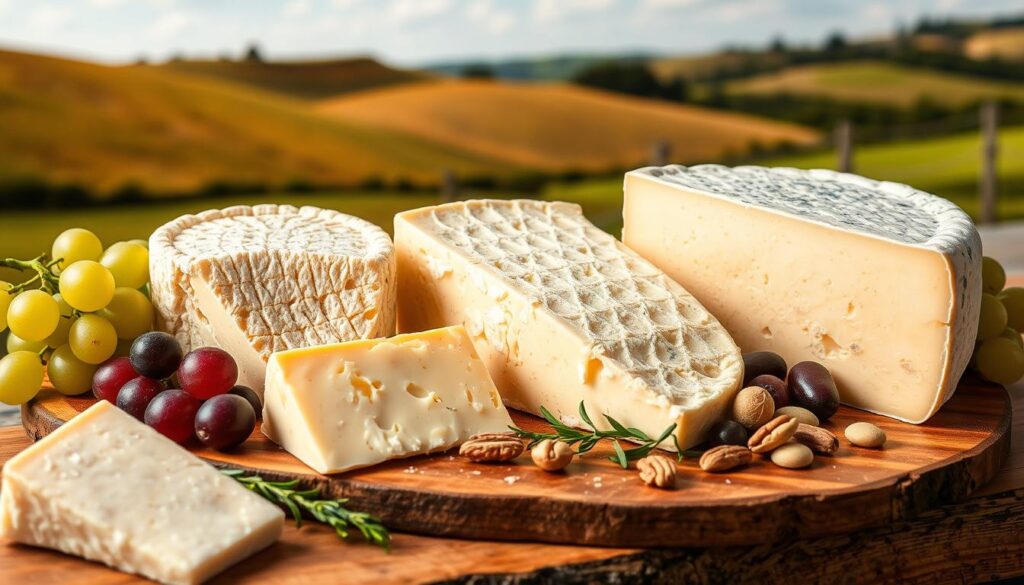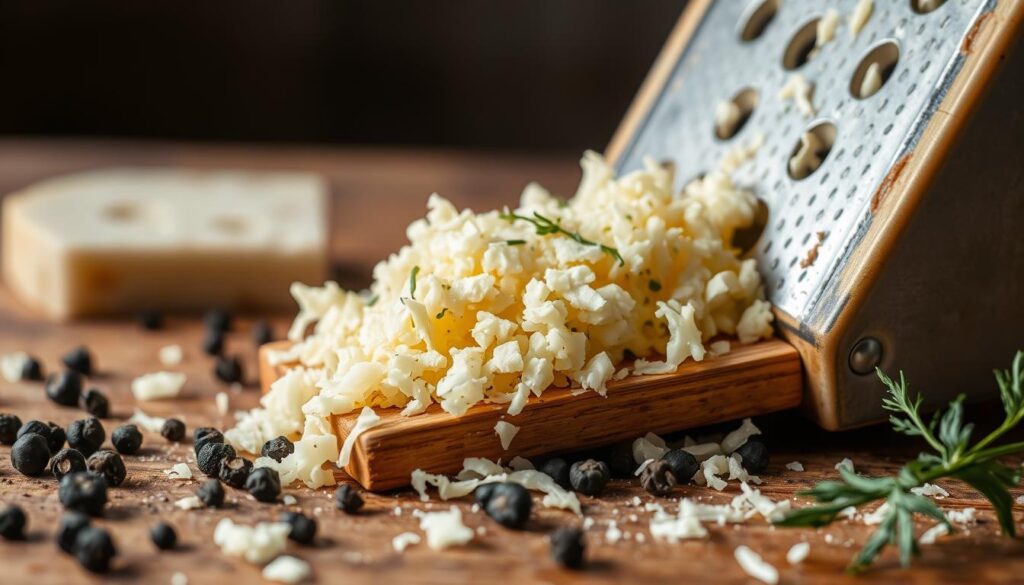
Table of Contents
I love exploring the rich flavors of Italian cheeses. Pecorino cheeses are a favorite of mine. They range from tangy Pecorino Romano to fragrant Pecorino Siciliano. These cheeses are not just tasty but also carry a long history in cooking.
In this guide, we’ll dive into Pecorino cheese. We’ll cover its origins, unique traits, and how to use it in cooking. Whether you’re a cheese expert or just starting out, get ready for a tasty adventure with Pecorino.
Understanding Pecorino: Italy’s Beloved Sheep’s Milk Cheese
Pecorino is a cherished Italian cheese with a long history. It dates back to ancient Roman times. Sheep farming has always been key in rural Italy, and making Pecorino is a tradition passed down through generations.
This cheese is made from the milk of grass-fed and wild-bred sheep. It has a unique flavor that makes it stand out from other cheeses.
Origins and Historical Significance
Pecorino’s history goes back to ancient Rome. It was a mainstay in the army’s diet because of its long shelf life and nutritional value. Over time, making Pecorino has been a big part of Italy’s farming scene.
It’s especially important in places like Lazio, Sardinia, and Tuscany. There, it’s a big part of the local culture and food.
What Makes Pecorino Different from Other Cheeses
Pecorino is special because it’s made from sheep’s milk. This gives it a bold, tangy, and slightly salty taste. It also has a firm, dense texture that gets even more pronounced as it ages.
This unique taste makes Pecorino a favorite in Italian cooking. It’s often used in pasta dishes, salads, and as a topping for savory dishes.
Protected Designation of Origin (PDO) Status
To keep Pecorino authentic and high-quality, some types have the Protected Designation of Origin (PDO) status. This status means the cheese is made in specific areas of Italy using traditional methods. It helps preserve the cheese’s unique taste and quality.
Pecorino’s history and its current status as a beloved cheese show its importance in Italian cuisine. It highlights the value of sheep’s milk artisanal cheese in Italy. Its PDO status ensures its special qualities are kept for future generations.
Main Types of Pecorino and Their Characteristics
Pecorino is a beloved Italian sheep’s milk cheese with several distinct varieties. Each type possesses its own unique flavors and qualities. You’ll find four main types that stand out:
Pecorino Romano is the most famous. Pecorino offers a bold, salty flavor and a firm, hard texture. It’s often grated or used in cooking. Pecorino Toscano is milder and enjoyed as a table cheese.
Pecorino Sardo comes from Sardinia and has a rich, full-bodied flavor. It can be smoked to enhance its taste. Pecorino Siciliano from Sicily has a tangy, slightly spicy taste. It may also have peppercorns or pistachios added.
| Variety | Flavor Profile | Texture | Common Uses |
|---|---|---|---|
| Pecorino Romano | Sharp, salty | Hard | Grating, cooking |
| Pecorino Toscano | Mild | Soft to semi-firm | Table cheese |
| Pecorino Sardo | Rich, full-bodied | Firm | Can be smoked |
| Pecorino Siciliano | Tangy, slightly spicy | Firm | Can be infused with ingredients |
All Pecorino cheeses share a common heritage. They are known for their exceptional quality and versatility in the kitchen.

Flavor Profiles and Texture Analysis
Pecorino’s unique taste and texture come from its regional roots and aging process. The salty taste and aged texture of this Italian sheep’s milk cheese change based on its production area and aging time.
Taste Variations by Region
Pecorino cheeses from Italy’s different regions have unique flavors. Pecorino Romano is known for its strong, salty taste. On the other hand, Pecorino Toscano is milder and nuttier. The climate, sheep’s diet, and cheesemaking methods all affect the flavor profile of Pecorino.
Aging Process and Its Effects
The aging process is key to Pecorino’s cheese texture and salty flavor. Fresh Pecorino, aged less than 30 days, is soft and mild. As it ages, it gets harder, saltier, and more complex, with notes of nuts, butter, and a peppery kick.
Comparing Fresh vs. Aged Varieties
- Soft young Pecorino, aged for 20-30 days, has a soft, spreadable texture and a mild, delicate flavor.
- Semistagionato Pecorino, aged up to 2 months, develops a firmer texture and a more pronounced, nutty taste.
- Aged Pecorino, matured for over 6 months, becomes hard, salty, and complex, with a robust, umami-rich flavor profile.
These changes in cheese texture and salty flavor make Pecorino great for many dishes. It’s perfect for fresh salads and hearty pasta dishes.
Culinary Applications and Best Uses
Pecorino, the beloved Italian sheep’s milk cheese, is a versatile ingredient in the kitchen. Its rich, complex flavor and firm, grated texture make it a popular choice for a variety of dishes. From classic pasta dishes to savory custards, Pecorino can elevate your culinary creations with its unique taste profile.
One of the most common uses for Pecorino is as a grating cheese for pasta dishes. Its high melting point allows it to maintain its shape when sprinkled over hot plates of pasta, soups, and salads. This adds a burst of salty, umami-rich flavor. Pecorino pairs exceptionally well with fruits like pears and figs, and a drizzle of honey can create a delightful sweet-savory contrast.
Pecorino is a key ingredient in classic Italian dishes such as Cacio e Pepe and Carbonara. Its sharp, tangy notes complement the other components perfectly. Its versatility extends beyond traditional recipes, as it can also be used in unconventional ways, such as in cheese crisps or as a flavoring for savory custards.
| Cuisine | Prep Time | Cook Time | Total Time | Servings |
|---|---|---|---|---|
| Mediterranean | 20 minutes | 22 minutes | 42 minutes | 9 |
The recipe for these Pecorino-infused Frittata Sandwiches showcases the cheese’s versatility. The egg mixture contains 1 cup of Pecorino Romano PDO. The final dish yields 9 pieces, each with 2 ounces of grated Pecorino Romano PDO. Paired with 1 1/2 cups of plain full-fat Greek yogurt, this recipe offers a delicious and nutritious way to incorporate the flavors of Pecorino into your culinary repertoire.

“Pecorino is an essential ingredient in any Italian kitchen, perfect for adding depth to classic pasta dishes or experimenting with new culinary creations. Its unique flavor profile and versatile applications make it an indispensable ingredient for any home cook or professional chef.”
Proper Storage and Handling Tips
To keep your Pecorino cheese fresh, store it properly. Wrap it tightly in cling film, foil, or parchment paper. Afterward, place it in an airtight container and store it in the fridge.
The best fridge temperature for Pecorino is 35 to 45 degrees Fahrenheit. This keeps the cheese’s texture and taste perfect.
Freezing Pecorino for up to 9 months is also an option. Just make sure to wrap it well. When you’re ready to eat it, let it warm up to room temperature. This brings out all the flavors.
Using a cheese dome or a container that controls humidity can also help. It prevents the cheese from drying out.
By following these storage and handling tips, your Pecorino cheese will stay top-notch. Enjoy its rich, authentic taste for weeks or even months.
FAQ
What is Pecorino cheese?
Pecorino is a type of Italian cheese made from sheep’s milk. It includes varieties like Romano, Toscano, Sardo, and Siciliano. The name comes from “pecora,” meaning sheep in Italian. It’s known for its firm texture and salty taste, often compared to Parmigiano Reggiano.
What is the history and significance of Pecorino cheese?
Pecorino cheese has ancient roots, dating back to Roman times. Sheep farming was crucial in rural Italy. The cheese was valued for its long shelf life and was a favorite in the Roman army’s diet.
Its use of sheep’s milk gives it a unique flavor. The Protected Designation of Origin (PDO) status ensures its quality and authenticity. Each variety is made in specific Italian regions using traditional methods.
What are the main types of Pecorino cheese?
There are four main types of Pecorino cheese. Pecorino Romano is famous for its sharp, salty taste and hard texture. Pecorino Toscano is milder and great as a table cheese.
Pecorino Sardo, from Sardinia, has a rich flavor and can be smoked. Pecorino Siciliano, from Sicily, has a tangy, slightly spicy taste. It can be infused with ingredients like peppercorns or pistachios.
How does the flavor and texture of Pecorino vary?
The flavor and texture of Pecorino change based on where it’s made and how long it’s aged. Fresh Pecorino is softer and milder. Aged varieties are harder, saltier, and more complex.
The aging process can last from 20 days to over 18 months. The taste can range from nutty and salty to mild and sharp. This is influenced by the sheep’s diet and local climate.
How is Pecorino used in the kitchen?
Pecorino is versatile in cooking. It’s often grated over pasta, soups, and salads. It pairs well with fruits like pears and figs and can be drizzled with honey for a sweet-savory contrast.
Pecorino is a key ingredient in classic Italian dishes like Cacio e Pepe and Carbonara. Its high melting point makes it perfect for grating over hot dishes. It can also be used in cheese crisps or as a flavoring for savory custards.
How should Pecorino cheese be stored?
Store Pecorino wrapped tightly in cling film, foil, or parchment paper in an airtight container in the fridge. The ideal temperature is between 35 to 45 degrees Fahrenheit. It can be frozen for up to 9 months if wrapped properly.
When serving, let the cheese come to room temperature for the best flavor. For long-term storage, use a cheese dome to keep the right humidity levels and prevent drying out.
